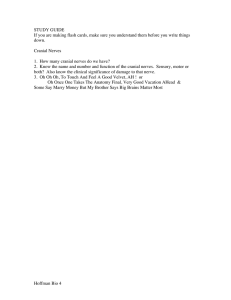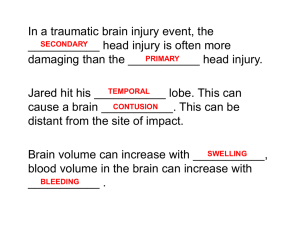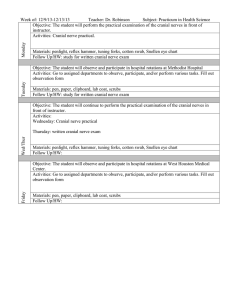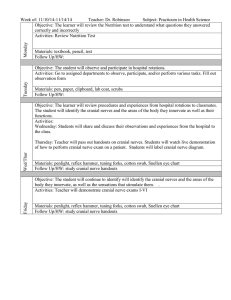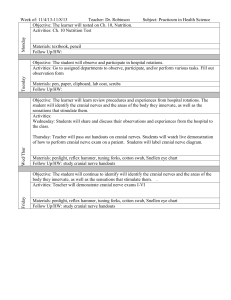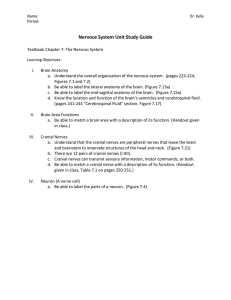Changes in Cranial Base Morphology in Class I and Class II
advertisement
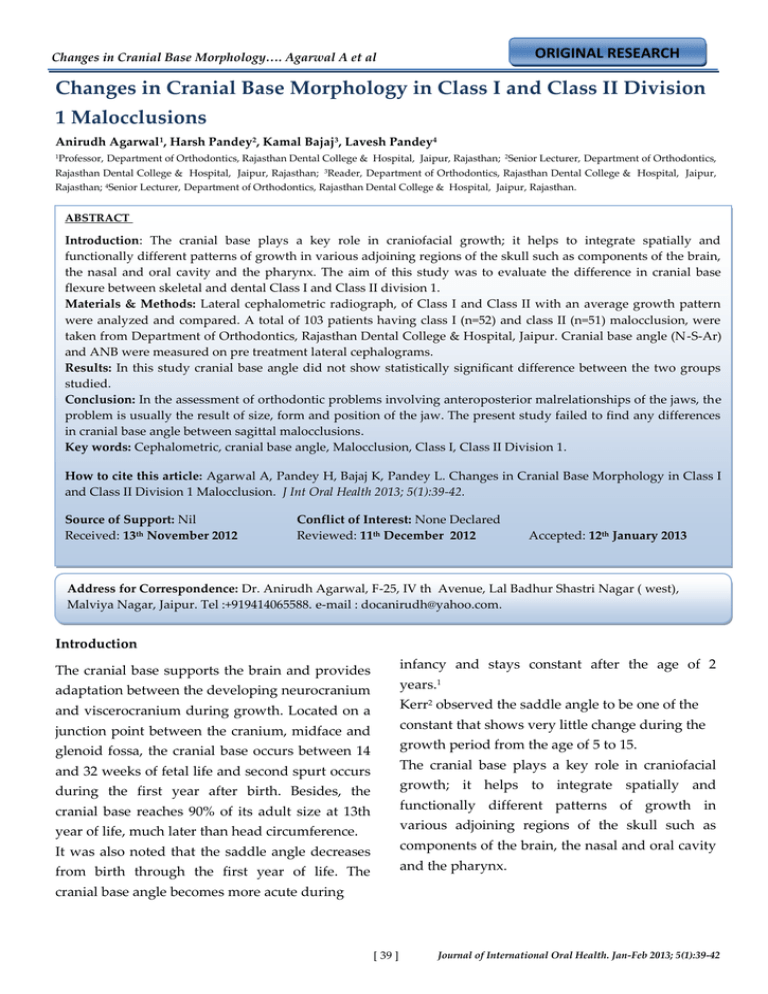
ORIGINAL RESEARCH Changes in Cranial Base Morphology…. Agarwal A et al Changes in Cranial Base Morphology in Class I and Class II Division 1 Malocclusions Anirudh Agarwal1, Harsh Pandey2, Kamal Bajaj3, Lavesh Pandey4 1Professor, Department of Orthodontics, Rajasthan Dental College & Hospital, Jaipur, Rajasthan; 2Senior Lecturer, Department of Orthodontics, Rajasthan Dental College & Hospital, Jaipur, Rajasthan; 3Reader, Department of Orthodontics, Rajasthan Dental College & Hospital, Jaipur, Rajasthan; 4Senior Lecturer, Department of Orthodontics, Rajasthan Dental College & Hospital, Jaipur, Rajasthan. ABSTRACT Introduction: The cranial base plays a key role in craniofacial growth; it helps to integrate spatially and functionally different patterns of growth in various adjoining regions of the skull such as components of the brain, the nasal and oral cavity and the pharynx. The aim of this study was to evaluate the difference in cranial base flexure between skeletal and dental Class I and Class II division 1. Materials & Methods: Lateral cephalometric radiograph, of Class I and Class II with an average growth pattern were analyzed and compared. A total of 103 patients having class I (n=52) and class II (n=51) malocclusion, were taken from Department of Orthodontics, Rajasthan Dental College & Hospital, Jaipur. Cranial base angle (N-S-Ar) and ANB were measured on pre treatment lateral cephalograms. Results: In this study cranial base angle did not show statistically significant difference between the two groups studied. Conclusion: In the assessment of orthodontic problems involving anteroposterior malrelationships of the jaws, the problem is usually the result of size, form and position of the jaw. The present study failed to find any differences in cranial base angle between sagittal malocclusions. Key words: Cephalometric, cranial base angle, Malocclusion, Class I, Class II Division 1. How to cite this article: Agarwal A, Pandey H, Bajaj K, Pandey L. Changes in Cranial Base Morphology in Class I and Class II Division 1 Malocclusion. J Int Oral Health 2013; 5(1):39-42. Source of Support: Nil Received: 13th November 2012 Conflict of Interest: None Declared Reviewed: 11th December 2012 Accepted: 12th January 2013 Address for Correspondence: Dr. Anirudh Agarwal, F-25, IV th Avenue, Lal Badhur Shastri Nagar ( west), Malviya Nagar, Jaipur. Tel :+919414065588. e-mail : docanirudh@yahoo.com. Introduction The cranial base supports the brain and provides infancy and stays constant after the age of 2 adaptation between the developing neurocranium years.1 and viscerocranium during growth. Located on a Kerr2 observed the saddle angle to be one of the junction point between the cranium, midface and constant that shows very little change during the glenoid fossa, the cranial base occurs between 14 growth period from the age of 5 to 15. and 32 weeks of fetal life and second spurt occurs The cranial base plays a key role in craniofacial during the first year after birth. Besides, the growth; it helps to integrate spatially and cranial base reaches 90% of its adult size at 13th functionally different patterns of growth in year of life, much later than head circumference. various adjoining regions of the skull such as It was also noted that the saddle angle decreases components of the brain, the nasal and oral cavity from birth through the first year of life. The and the pharynx. cranial base angle becomes more acute during [ 39 ] Journal of International Oral Health. Jan-Feb 2013; 5(1):39-42 ORIGINAL RESEARCH Changes in Cranial Base Morphology…. Agarwal A et al Depending on the fact that the maxilla is condylar neck is positioned more posterior in connected with the anterior part of the cranial class II individuals. Other researches have reported similar findings Table 1: T-test: Two-sample assuming and concluded that the cranial base flexure is unequal variance more obtuse, S-N (anterior cranial base) and S-Ba Class I Class II (posterior cranial base) lengths are longer and the division 1 condylar neck is positioned more posterior in Mean 123.81812 124.0562 class II individuals. Variance 14.72727 21.7193 Different factors like basicranial morphology, Standard 3.837 4.660 head and neck posture and soft tissue stretching deviation are thought to influence the occurrence of a Observations 52 Hypothesized 0 51 skeletal malocclusion. The influence of cranial base angulations as a mean factor in the etiology of sagittal jaw discrepancies difference is still a matter of debate. t start -0.17414 P (T<=t) one- 0.431378 Kasai et al between Class I And Class II samples. Similarly, Wilhelm et al. 7 did not observe any differences tail 0.862757 t critical two- 2.030108 maxillofacial Morphology in Japanese crania and did not find differences 1.689572 P (T<=t)two-tail investigated the relationship of the cranial base and tail t critical one- 6 For the cranial base measurements between the Class I and Class II Skeletal patterns. Different studies sustaining these findings are also present 7, 8 tail Aim: base and the rotation of the mandible is influenced by the maxilla, a relationship can be The purpose of this cross-sectional retrospective found between the cranial base variations and study is to investigate any possible differences in sagittal malpositions of the jaws. the shape and position of the cranial base in Class Hopkin et al I, Class II division 1 skeletal patterns. 3 found that the cranial base length and angle increase from Angle class III through Class I to Class II Div I malocclusion. Material and methods: Anderson4 and Popovitch observed that the Lateral cephalometric films were obtained from individuals with the largest cranial base angle the initial records of 103 patients, having class I showed a Class II tendency. [n=52, (27 male and 25 female)] and class II [n=51, Jarvinen noted that Class II patients showed a (25 male and 26 female], who presented for higher ArSN angle than Class III patients. seeking orthodontic treatment at Department of Other researches have reported similar findings Orthodontics. and concluded that the cranial base flexure is The criteria for the selection of patients were: 5 more obtuse, S-N (anterior cranial base) and S-Ba (posterior cranial base) lengths are longer and the [ 40 ] Journal of International Oral Health. Jan-Feb 2013; 5(1):39-42 ORIGINAL RESEARCH Changes in Cranial Base Morphology…. Agarwal A et al Group 1: Skeletal class I malocclusion with an Differences between the groups were evaluated ANB angle of 2 ± 2°, favorable overjet and using‘t’ overbite and minimal crowding of both arches. predetermined as p<0.05. Test. Significance for tests was Group 2: Skeletal Class II division 1 malocclusion with an ANB angle of +5° or more, increased Results: overjet. The cranial base flexure was evaluated according Patients, who presented any oral habit (as to determined from the history), were excluded angle showed the gradual increase from class I to from the study. class II division I (Table 1). No significant All of the patients were at the post pubertal differences were measured between the groups. N-S-Ar angular measurements.The N-S-Ar growth spurt stage according to cervical vertebrae maturation index (CV4 developmental stage). Discussion: In the assessment of orthodontic problems Cephalometric analysis: involving anteroposterior malrelationships of the The lateral cephalometric radiographs of each jaws, the problem is usually the result of size, subject were taken with a Soredex Cranex form and position of the jaw. Cephalometer at Department of Oral Medicine Despite the effects of head posture, breathing and Radiology, Rajasthan Dental College & mode or even spine position that have been Hospital, Jaipur. shown to influence craniofacial morphology, All subjects were positioned in the cephalostat cranial base flexion has been put forward to be a with the sagittal plane at a right angle to the path possible indicator of a skeletal malocclusion. of the X-rays, the Frankfort plane parallel to the The study failed to demonstrate any differences in horizontal, the teeth in centric occlusion, and the cranial base flexure in different malocclusions. lips slightly closed. Due to the present controversy, the main purpose The radiographs were hand traced and were of the present study was to investigate, in a cross- measured. sectional sample, whether the cranial base flexure The following landmarks were used for or the shape of the cranial base could show cephalometric analysis: point A (A), morphological differences in skeletal class I, and Point B (B), sella(S), nasion (N), articulare (Ar). class II division 1 malocclusions. The following measurements were used: It is difficult to exclude all possible factors that Angular measurements for the assessment of influence the occurrence of a skeletal dysplasia. sagittal Angular In choosing the class I and class II samples, care measurements for the assessment of cranial base was given not to choose subjects who have flexure: N-S-Ar. extremely small or huge jaws. growth pattern: ANB Mouth breathers or patients with any other oral Statistical analysis: The mean and habits were excluded to minimize the effects of standard deviations were any other etiological factor that play a role in estimated for each cephalometric variable in each development of a specific skeletal class. group. The results of this study failed to demonstrate any The intra operator error was not significant. differences between the two groups studied in cranial base angle measured articulare. [ 41 ] Journal of International Oral Health. Jan-Feb 2013; 5(1):39-42 ORIGINAL RESEARCH Changes in Cranial Base Morphology…. Agarwal A et al These results were consistent with the findings of 4. Anderson DL, Popovich F. Lower cranial Hildwein et al.9, Kasai et al. 6 And Wilhelm et al. 7 height versus craniofacial dimension in angle It has been suggested that cranial base flexure class influences Orthod1983;53(3):253-60. mandibular prognathism by determining the anteroposterior position of the II malocclusion. Angle 5. Jarvinen S. Saddle angle and maxillary condyle relative to the facial profile.10 prognathism: a radiological analysis of the association between the NSAr and SNA Conclusions: angles. Br J Orthod 1984;11(4):209-13. 6. Kasai K, Moro T, Kanazawa E, Iwasawa T. Cranial base angle measurements: (N-S-Ar) did significantly Relationship differences between the malocclusions .Clearly, maxillofacial the cranial base angle is not the only factor in Orthod1995;17(5):403-10. not demonstrate statistically 7. determining a malocclusion. between cranial morphology. base and Eur J Wilhelm BM, Beck FM, Lidral AC, Vig KW. A According to Scott 11, three main factors influence comparison of cranial base growth in class I facial prognathism - opening of the cranial base and class II skeletal patterns. Am J Orthod angle, Dentofac Orthop.2001;119(4):401-5. the relative forward movement of components such as the maxilla and the mandible 8. Rothstein T, Phan XL. Dental and facial to the cranium and the amount of surface skeletal characteristics and growth of females deposition along the facial profile between the and nation and menton. malocclusion between the ages of 10 and 14. The present study failed to find any differences in Am cranial base angle between sagittal malocclusions. ;120(5):542-55. males J with Orthod Class Dentofacial II division Orthop 1 2001 9. Hildwein M, Bacon W, Turlot JC, Kuntz M. Spe´cificite´s et discriminants majeurs dans References: une population de Classe II division 1 1. Lewis AB, Roche AF. The saddle angle: d_Angle. Revue d_Orthope´die Dento-Faciale constancy or change? Angle Orthod 1977; 1986; 20:197–298. 47:46–54. 10. Sarnas KV. Inter- and intra-family variations 2. Kerr WJ, Hirst D. Craniofacial characteristics in facial profile. Odont Rev 1959; 10(Suppl. 4) of subjects with normal and post normal 11. Scott JH. Dento-facial Development and occlusions. Am J Orthod Dentofacial Orthop Growth. Oxford: Pergamon Press; 1967. 1987;92(3):207-12. 3. Hopkin GB. Mesio-occlusion, a clinical and roentgenographic cephalometric study. PhD Thesis. Edinburgh: University of Edinburgh; 1961. [ 42 ] Journal of International Oral Health. Jan-Feb 2013; 5(1):39-42
